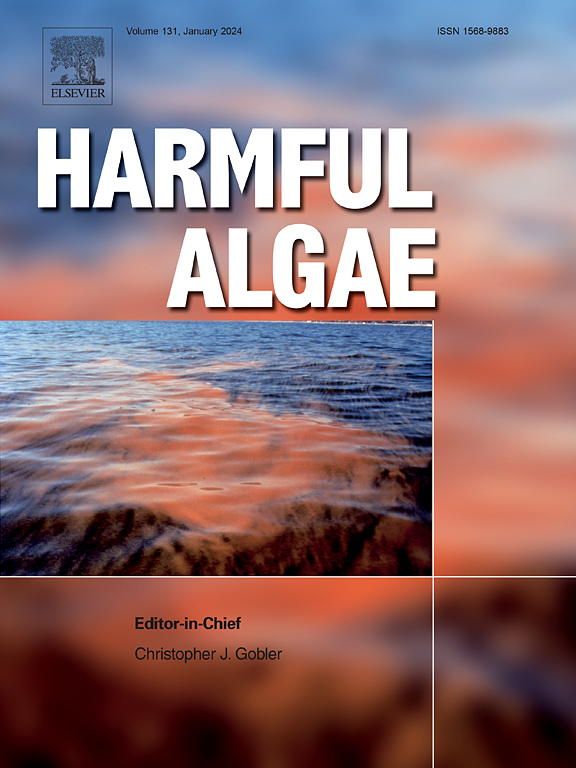Extracellular polymeric substances enhanced photosynthesis over respiration in Microcystis aeruginosa
IF 4.5
1区 生物学
Q1 MARINE & FRESHWATER BIOLOGY
引用次数: 0
Abstract
Extracellular polymeric substances (EPS) play a critical role in Microcystis-dominated freshwater cyanobacterial blooms. However, the mechanisms through which EPS affects Microcystis photosynthesis, respiration, and further affects its growth are not understood completely. To address this, we investigated the effects of varying EPS concentrations on the physiological processes of Microcystis aeruginosa. The results demonstrated that increasing EPS concentrations significantly enhanced both cell density and energy fixation efficiency, accompanied by a reduction in CO2 emission flux. Specifically, compared with the control group, the addition of 20 mg·L-¹ EPS increased respiratory rates by 2.14 μmol·mg·h-¹ and photosynthetic rates by 2.48 μmol·mg·h-¹, suggesting that EPS stimulated both respiration and photosynthesis, with a more pronounced effect on photosynthesis, thereby leading to a substantial increase in algal growth. Further analysis indicated that EPS enhanced respiration by retaining hydrolases capable of breaking down macromolecules into bioavailable micromolecular substrates, which elevated acetyl-CoA concentrations and citrate synthase activity, thus improving respiratory efficiency. In terms of photosynthesis, EPS enhanced light utilization, as indicated by an increase in FV/FM, and improved the efficiency of inorganic carbon supply by enriching CO2 and creating extracellular inorganic carbon gradients. Moreover, EPS enhanced the activities of carbonic anhydrase and ribulose bisphosphate carboxylase/oxygenase. These findings emphasize the essential role of EPS in promoting algal growth and its potential impact on CO2 fixation. Future research should incorporate the role of EPS in reducing carbon limitation into discussions of algal growth mechanisms and develop technologies that use algal blooms to harvest high-value carbon products such as ethanol, astaxanthin, lipids, and other valuable compounds.

胞外聚合物质对铜绿微囊藻光合作用的促进作用大于呼吸作用
胞外聚合物质(EPS)在微囊藻为主的淡水蓝藻华中起着关键作用。然而,EPS影响微囊藻光合作用、呼吸作用并进而影响其生长的机制尚不完全清楚。为了解决这个问题,我们研究了不同EPS浓度对铜绿微囊藻生理过程的影响。结果表明,EPS浓度的增加显著提高了细胞密度和能量固定效率,同时降低了CO2排放通量。其中,与对照组相比,添加20 mg·L-¹EPS可使藻类呼吸速率提高2.14 μmol·mg·h-¹,光合速率提高2.48 μmol·mg·h-¹,说明EPS既刺激了呼吸作用,又刺激了光合作用,且对光合作用的影响更为明显,从而显著促进了藻类的生长。进一步分析表明,EPS通过保留能够将大分子分解为生物可利用的微分子底物的水解酶来增强呼吸作用,从而提高乙酰辅酶a浓度和柠檬酸合成酶活性,从而提高呼吸效率。在光合作用方面,EPS通过增加FV/FM提高了光利用率,并通过富集CO2和形成细胞外无机碳梯度提高了无机碳供应效率。此外,EPS还增强了碳酸酐酶和二磷酸核酮糖羧化酶/加氧酶的活性。这些发现强调了EPS在促进藻类生长及其对二氧化碳固定的潜在影响中的重要作用。未来的研究应将EPS在减少碳限制方面的作用纳入藻类生长机制的讨论中,并开发利用藻华收获高价值碳产品(如乙醇、虾青素、脂质和其他有价值的化合物)的技术。
本文章由计算机程序翻译,如有差异,请以英文原文为准。
求助全文
约1分钟内获得全文
求助全文
来源期刊

Harmful Algae
生物-海洋与淡水生物学
CiteScore
12.50
自引率
15.20%
发文量
122
审稿时长
7.5 months
期刊介绍:
This journal provides a forum to promote knowledge of harmful microalgae and macroalgae, including cyanobacteria, as well as monitoring, management and control of these organisms.
 求助内容:
求助内容: 应助结果提醒方式:
应助结果提醒方式:


